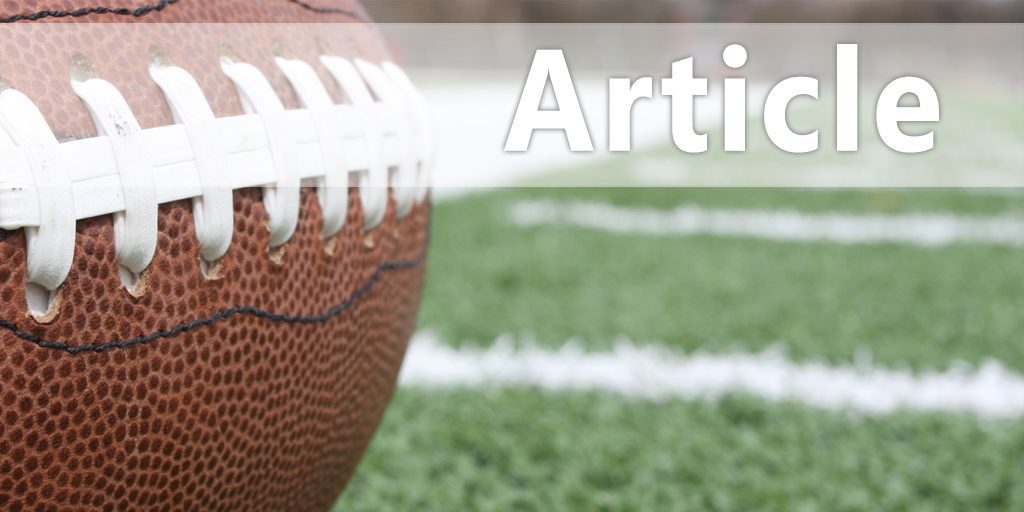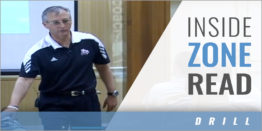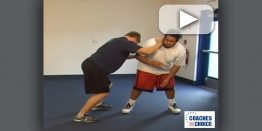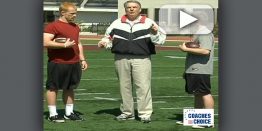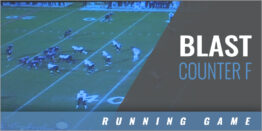| Executing the No-Huddle Spread Offense
I want to give you some background about Sayville football. We ran the power-I formation for 79 years. The offensive linemen aligned in four- point stances. The fullback and tailback were in three-point stances. In our present offense, the closest we get to the ground is our center touching the ball. While we were running the power-I, we won eight Suffolk County championships, five Long Island championships, three Rutgers trophies, and 342 games. In 2006, we had just won the Long Island championship. I went in to the coaches meeting and told them we were going to the spread. I made many enemies in that room. If you have a chance to go to the spread and your team is not winning, you do not have much to lose. You should not be afraid to do it because you have nothing to do but gain. If you are winning, the question is why you would change. In 2006, we had a massive offensive line. We were huge, and we lined up and blew people off the line of scrimmage. We lost all of them to graduation. The offensive linemen we had coming back were small and our chance of moving defenders around was almost nothing. We thought our best chance of winning was running a high-risk and high-reward offense. We went to the no-huddle spread offense. If you are not sure about this offense, look at what we did in the five-year period since the installation. If you are in an offense and not getting results, you need to take a risk and run this offense. It will pay dividends for you. HIGH RISK, HIGH REWARD • 46-9 record SAY VILLE OFFENSIVE GOALS • To outscore our opponent—this will ensure victory I talked to my defensive coordinator and asked him how many points we needed to score. He told me if we score four touchdowns a game, we would win the game. That plan worked every game of the year until the Long Island championship game. I do not know what happened in that game. We got beat and did not score the 12 times we had the ball. In our games this year, our starting defense only gave up two touchdowns this year. We gave up more touchdowns, but the starting defense only gave up two. If we score four touchdowns a game, we will win. When we write it down, we have to tell our offensive players that this is our goal. You have to preach and teach your goals to your players. We want to have 350 yards of total offense a game. There was one game this year that we did not have 350 yards of total offense. In that game, our starting quarterback broke his nose on the first play of the game. He had to go to the hospital. We played the rest of the game with our starting tailback playing quarterback. It was one of the hottest games of the year, and we played in a torrential rainstorm. The field was a quagmire. If you have an athlete in this offense, he can still be successful. Next year, our starting quarterback may be our tailback. SAYVILLE'S OFFENSIVE OBJECTIVES
We are an attacking offense. We want to pressure the defense and make it adjust to what we do. We believe that the turnover ratio is a tremendously important factor to winning the game. If we win the coin toss, we never defer. We want the ball because we want to score first, and we want to do it fast. If you can do that, it puts additional pressure on the opponent's defense. The good thing about the spread offense is that it spreads the ball around to your athletes. They are all part of the whole team game. BENEFITS OF THE SPREAD • Allows the offense to create the tempo of the anne The defensive coordinators want to see the offense get into the huddle and call its plays. The coordinator wants to control his personnel and call the defense on his terms. We want to destroy his ability to do that. We want to control what he does. We want him to defend the entire field. We want to create space and force the defense to play in that area. One of the hardest things to do in football is to tackle a running back in the open field. By going at a rapid pace, the defense cannot disguise its coverages and blitzes. It takes away their bluffs and mugs by the linebackers. We want to find the mismatches in the defense. We use formations to isolate our best on their worst. We use multiple formations to create those mismatches. If it is zone coverage, we teach our players what to do in that situation. This offense handles movement. It does not matter if you blitz or slant. We run the zone scheme from the spread, but you can also run the power game from the spread. You cannot believe how many power schemes you can run from this formation. The defense wants to play against the two-tight-end, three-back sets. When you play the spread, you force the defense to become more athletic. They cannot play the slot receivers, running backs, quarterbacks, and wide receivers in space with linemen and linebackers. You force the defense to put defensive backs and athletes on the field. WHY THE NO-HUDDLE
When we practice, we practice in the no-huddle speed. The linemen are at the point of the ball, and the receivers deploy during the spotting of the ball instead of going into a huddle and running back to where they just came from. Our players do not know how to get in a huddle. We never huddle at any time in practice or in a game. The only time we come close to a huddle is a fourth-down play during a time-out on the sideline. Did you know it is 17 yards from the sideline to the hash? Consider how many yards the no-huddle saves our quarterback:
If you want to throw the ball, we want the quarterback looking straight up the field at the defense. We do not want his back to the line of scrimmage in a huddle. He has a chance to fake a snap so the defense tips its hand and show what it is going to do. On occasion, we run a freeze call, which is a no-play call, and try to draw the defenseoffside or make it show its hand. That type of play by the quarterback confuses the defense as to whether to run the blitz or check out of it. We have a number of tempos we use during a game. One of those speeds is warp speed. When we run a play at that speed, we repeat the previous play. We do not call anything; we run the same play on the first sound. The quarterback does not look to the sideline and the line does not listen for an audible. That prevents the defense from running any type of stunt. All it can hope for is to align properly. We may play regular tempo for four or five plays and run the warp speed tempo for one play. We may run regular for two plays and hit them with the warp speed tempo again. If you find a team that uses wristbands as part of their scheme, the no-huddle team affects them tremendously. The wristbands are their communication devises for the coaches and players. They do not have time to look at the wristbands. Therefore, we cut his lines of communications from the coach and players. He ends up in the wrong technique or running the wrong movement. If we are in a regular huddle on offense, we have to ask the team to get up from a point on the field and jog back to a huddle in the middle of the field. After the huddle, they have to jog the 8 to 10 yards to the line of scrimmage. That is a waste of energy. Do not make the quarterback and linemen run additional and extra yards during the course of the game. COMMUNICATION • Wristbands • Hand/Body Signals • Verbal I do not like the wristband system because it is too confining as to the number of plays you can get on a wristband. They are hard to read, and weather affects them. I do not want the players looking at the wristbands. I want them looking at the defense. Hand signals are okay for signaling base plays. However, you cannot get into the game in a quick amount of time what we need to communicate. You cannot get a huge amount of information to your team with a hand signal. Hand signals do not work for me. I like the verbal system. The coach calls the play from his sideline. He shouts it to the receiver to his bench, and that receiver relays the call straight down the line. It goes from wide receiver to slot receiver to quarterback and offensive line to opposite side receiver. I am not saying the verbal system is the best; it is what works for us. The wristbands and hand signals may be what work best for you. I prefer to use the verbal communication. SILENT COUNT We use a silent count. That does not mean we have to use it, but we believe in it, We never use a count unless we know when to go. We give them a code. We have a code when we go on one and a code when we go on two. When we talk about the code, your players must know what you are saying. lf you use a word five times in a row, and five times in a row you go right, the defense may notice that. However, when we use the code words, the defense does not know if we are talking about a player, a direction, or a play. I do not believe the defense can crack the code we use. There are too many variables for them to notice. THE CODE In our offense, we try to balance the running game with the passing game. In the past five years, we ran the ball 1,796 times. We gained over 10,000 yards. We threw the ball 1,036 times and completed 633 passes. We passed for 9,836 yards in five years. That amounts to running the ball 63 percent of the time and throwing it 37 percent of the time. In recent years, we are probably closer to 60 percent run and 40 percent pass. We feel that is a balanced attack. We use a multiple tempo system. We have three tempos. We use slow, fast, and warp speed tempos. In our offense, we are unpredictable in our play calling. If we are backed up in our own territory, we want to throw on first and 10 yards for the first down. Coaches do not normally throw from their own one-yard line, but we will. Never let the defense know what you are going to do. Make them play when you are backed up as they would from the middle of the field. Never let the defense dig in. KEYS TO THE RUNNING GAME lf we run the zone play, I like to run that to the shade defender rather than the 3 technique. We would rather trap the 3 technique. Keep a balance between the ballcarriers. Do not let the defense concentrate on one ballcarrier. Attack them from all areas and with multiple ballcarriers. If you cannot figure out where to run and everything on the defense seems to be equal, run to the wide side of the field. KEYS TO THE PASSING GAME Mirrored routes in our offense are huge. We pick a side and try to find the best match-up for our receivers. Once the quarterback decides which side is best, that is where he throws. If he thinks the right side is the best side, we throw to the right. We give our quarterbacks horizontal and vertical blitz control. The vertical hot pattern is the fade route. The horizontal hot pattern could be a bubble screen, jailbreak screen, running back swing, quick speed-out, or any number of things we can do. QUARTERBACK TIPS The quarterback has to find the weakness in the defense. It could be a blitz from the boundary, boundary man-to-man, or the field defenders misaligned, but he has to find the weakness. We do not want the quarterback to take a sack. If he cannot find a receiver, he has to throw the ball away. However, if he gets into a situation where he cannot throw it away, we want him to eat the ball and take the sack. We do not want him to attempt to throw the ball with someone hanging on him. Quarterbacks trying to get rid of the ball in those congested areas either fumble it or throw the ball to the defense. Last season, our quarterback threw the ball 216 times. He had 139 completions and 29 touchdowns. He took more sacks than he needed to, but that was due to my coaching. I always want to live to play the next down. If he throws an interception, we come off the field. When we start to coach our quarterback, the first thing we do is teach him how to identify the box. BOX DEA • Men in the box This is a pre-snap read that can and most likely will change after the snap of the ball. The box tells us if we want to run the ball or throw it. Reading the box will tell the quarterback what to do. The depth of the corner will tip the coverage. If the corner looks at the quarterback, it is probably some type of zone coverage. If he concentrates on the receiver, it is a man scheme. In the spread offense, the blitz will come from the outside linebacker in a two-high look. If the wide receiver to that side starts to yell "Hot, hot, hot," that is an alert for the quarterback to a blitz from that side, and he should think hot reads. He does not have to check the play but is alert to the possibility of the blitz and knows where the hot throw is. This offense has great adaptability. ADAPTABILITY In this offense, we are comfortable with the shotgun snap. When the field conditions are bad, we believe there is more insecurity under center than there is in the shotgun. We did not have one fumbled snap last year, and we had only one bad snap. MUST COMMITMENTS
The most important thing in this section is great spacing. We coach that from the first day. We tell the receiver the outside linebacker cannot play both the receiver and the run. If the receiver is into the boundary, he knows he has 17 yards, and he cannot allow the linebacker to play both games. He has to adjust his split so that the linebacker has to cover him or the quarterback throws to him. We simply tell the receiver, if the linebacker is so far inside where he cannot block him, the receiver is uncovered. The linebacker tells us he is a run defender. That leads us to the second commit. If the receiver To avoid linebackers and blitzes, we must be willing to move the quarterback from the pocket with sprint-out passing. The other alternative is to misdirect and get to the outside with the bootleg. Some coaches teach receivers to run routes. We teach them how to run routes. We teach them how to sink their hips, combat defenders, explode out of breaks, and identify zones and what to do against man coverage. If they play against zone coverage, they want to find open areas and stop their routes. If they play against man coverage, they have to run away from defenders to get open. They continue to run their patterns and never settle into an area. The receivers must be excellent blockers. The backside receiver can easily become the frontside blocker. On the zone option, the zone play run to the right can easily become the zone option to the left. The receiver has to stalk block on the corners and safeties. We start teaching that in a drill where the receivers must keep their hands behind their backs. They have to shuffle to get square on the target and stay in front of him. They have to use their feet to stay in front of the defender. We are not a big down-the-field team. Everyone thinks we are and play us with deep zones. We take what they give us. They give us all the short passing zones, and we take them. We want to give the ball to the playmakers in space and let them make big plays. When I come to a clinic, I want to learn one thing. At this clinic, I learned about a frontside deep read. When I go back, I ask myself the things in my final thoughts. FINAL THOUGHTS • How difficult will it be to defend? If you can answer those three questions, you can install the play or offense. Thank you!
|
|
|
